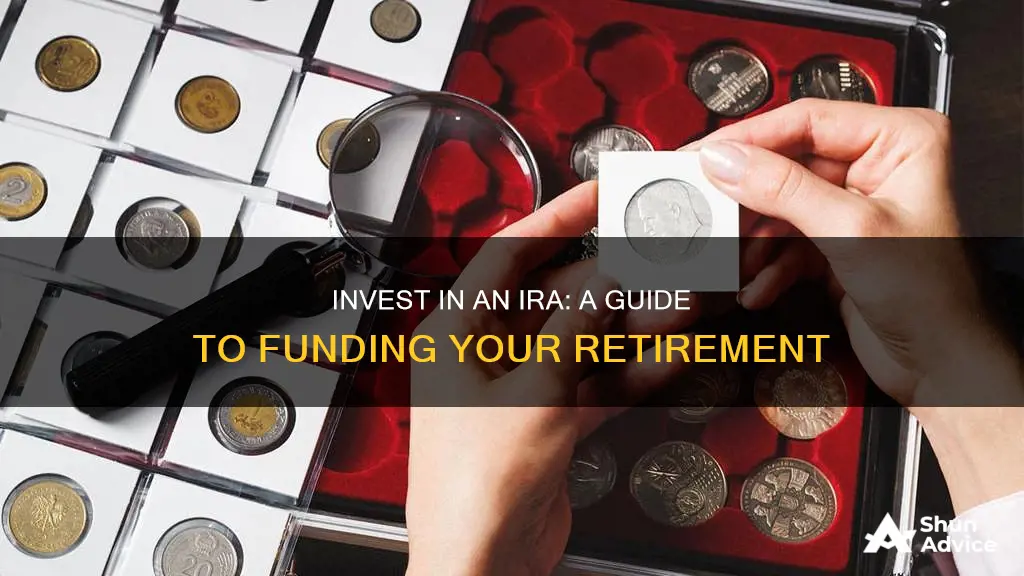
Investing in an IRA is a great way to save for retirement. There are different types of IRAs, each with its own benefits. For example, a traditional IRA offers tax benefits today, while a Roth IRA offers tax benefits in the future. With an IRA, you can invest in stocks, bonds, index funds, or mutual funds, and maximize your earnings. When choosing investments, it's important to consider your risk tolerance and investment timeframe. You can also seek professional advice or opt for all-in-one funds that provide a diversified portfolio with a preset investment mix.
| Characteristics | Values |
|---|---|
| Investment options | Individual stocks, mutual funds, exchange-traded funds (ETFs), robo-advisors, target-date funds, bonds, index funds, growth stocks, real estate investment trusts (REITs), high-yield bond funds |
| Considerations | Time horizon, risk tolerance, age, financial situation, growth potential, fees, tax implications |
| Steps | Understand asset allocation, consider risk tolerance, choose investment type (e.g. stocks, funds, or advisors), monitor and adjust as needed |
What You'll Learn

Understand asset allocation
Understanding asset allocation is a crucial step in investing your IRA funds. Asset allocation refers to how your money is divided across different types of investments, including stocks, bonds, cash, real estate, commodities, and more. The three main asset classes are equities, fixed income, and cash and cash equivalents, each carrying its own risks and return potential.
When allocating your IRA funds, you should consider your investment horizon, which is the amount of time before you need to withdraw your investments. If you start your IRA at a young age, you have a longer investment horizon, which means you can take on more risk with the potential for higher returns. As you get closer to retirement, you may want to adjust your asset allocation to reduce risk.
Your risk tolerance is another key factor in determining your asset allocation. If you have a low-risk tolerance, you may want to invest in more conservative assets, such as bonds or cash, even if you have a long-term investment horizon. On the other hand, if you are comfortable with risk, you may want to invest more heavily in stocks or other riskier assets.
It's important to diversify your IRA holdings across different asset classes to spread out the risk and capture gains in different sectors and industries. You can invest in a variety of assets, including stocks, bonds, funds, real estate, commodities, and cash, each offering its own benefits and drawbacks.
There is no one-size-fits-all approach to asset allocation, and it may become more complex if you have multiple investment accounts or specific financial goals. It's always a good idea to seek advice from a financial professional to help you create an asset allocation strategy that aligns with your unique circumstances and goals.
Strategic Investment: Maximizing Federal Funds for Long-term Growth
You may want to see also

Think about your risk tolerance
When it comes to investing in an IRA, it's important to consider your risk tolerance—that is, the degree of risk you're willing to take on. This will depend on a few factors, including your age, financial situation, investment goals, and investment experience.
Age
Your age is a key factor in determining your risk tolerance. Generally, younger investors are considered to have a higher risk tolerance, as they have a longer time horizon for their investments to grow and can afford to take on more risk. However, it's important to note that age is not the only factor at play, and even older investors may be able to remain aggressive investors if they have a long investment horizon.
Financial situation
Your financial situation will also impact your risk tolerance. If you have a high net worth and more liquid capital to spend, you may be able to afford to take on more risk. On the other hand, if you have a low net worth or limited risk capital, you may need to be more cautious.
Investment goals
Your investment goals will also play a role in determining your risk tolerance. For example, if you're saving for retirement, you may want to take on less risk to preserve your capital. On the other hand, if you're investing with disposable income and aiming for higher returns, you may be willing to take on more risk.
Investment experience
Your level of investment experience will also factor into your risk tolerance. If you're new to investing, it's generally advisable to start with a degree of caution and gain some experience before committing too much capital.
Other considerations
There are a few other factors that can impact your risk tolerance. For example, the time horizon for your investments—the longer the time horizon, the more aggressive you can be with your investments. Additionally, your future earning capacity and the presence of other assets can also affect your risk tolerance. If you have multiple sources of income or other stable assets, you may be able to take on more risk with your investments.
When considering your risk tolerance, it's important to be practical and honest with yourself. Assessing your financial circumstances, goals, and comfort level with risk will help you determine the right investment strategy for your IRA.
Unlocking Pension Funds: Impact Investing with Fitzpatrick and Omidyar
You may want to see also

Consider mutual funds
When it comes to investing in an IRA, there are a variety of options to consider, including mutual funds and exchange-traded funds (ETFs). Mutual funds are a good option for those who want a more hands-off approach to investing. With mutual funds, your money is pooled with money from other investors, and a professional portfolio manager makes investment decisions on your behalf. This can take some of the stress out of investing, as you don't need to spend time researching and planning. Mutual funds are also a good option for those who want to diversify their investments, as they allow you to invest in a broad range of assets, including stocks, bonds, or other securities. This diversification helps to spread risk and reduce the impact of any poor-performing individual investments.
There are several types of mutual funds to choose from, including equity funds, fixed-income funds, money market funds, and hybrid funds, which combine multiple types of funds. When choosing a mutual fund, it's important to consider the fees associated with them, as they can have higher expense ratios, especially when they are actively managed. Additionally, mutual funds may have minimum investment requirements, so be sure to review the details of the fund before investing.
Compared to ETFs, mutual funds may be less tax-efficient and may have higher expense ratios. However, they can still be a good option for those who want a more passive approach to investing and are willing to accept the associated fees and potential tax implications. When deciding between mutual funds and ETFs for your IRA, it's important to consider your financial goals, risk tolerance, and investment timeline.
Mutual Funds: Smart Investment, Smart Returns
You may want to see also

Know when to seek professional advice
When it comes to investing in an IRA, there are times when it may be beneficial to seek professional advice. Here are some scenarios where consulting a financial expert could be a wise decision:
- Risk and comfort level assessment: If you are unsure about your risk tolerance and comfort level with different investments, a financial advisor can help you assess your risk capacity and provide guidance on suitable investment options. They will consider factors such as your age, investment horizon, financial circumstances, and personal risk appetite to create a tailored plan.
- Portfolio management: If you don't have the time, expertise, or interest in selecting and managing investments, consider outsourcing this task to a professional. They can construct and oversee a diversified portfolio that aligns with your goals and risk tolerance. This can include services like target-date funds or robo-advisors, which offer low-cost portfolio management by automatically adjusting your investments as you approach retirement.
- Retirement planning: Retirement planning can be complex, especially if you have multiple retirement accounts or are approaching retirement age. A financial advisor can help you navigate important decisions, such as when to start taking distributions, how to minimise fees, and how your IRA fits into your overall retirement strategy. They can also assist with rollovers from old 401(k)s or other retirement plans into your IRA.
- Tax implications: Investing in an IRA has tax implications, and understanding the rules can be challenging. A financial professional can help you navigate the tax consequences of your investment choices, ensuring you make tax-efficient decisions. They can also guide you on strategies like tax-loss harvesting to minimise taxes and maximise returns.
- Complex financial situations: If you have a high net worth, own a business, or have a diverse range of investments, a financial advisor can provide valuable insight. They can help you navigate more sophisticated strategies, tax planning, estate planning, and ensure your IRA aligns with your overall financial plan.
- Ongoing support and monitoring: Financial advisors not only provide initial investment advice but also offer ongoing support and monitoring. They can help you stay on track by regularly reviewing your portfolio, rebalancing your investments, and making adjustments as needed to reflect changes in your life circumstances or the market conditions.
Remember, when seeking professional advice, it is important to find a qualified and trusted financial advisor who acts as a fiduciary. This means they are legally obligated to act in your best interest and disclose any potential conflicts of interest. Be sure to understand the fees involved and ask questions to ensure you are comfortable with the advice you are receiving.
Index Funds: Where to Start and What to Know
You may want to see also

Choose the right type of IRA for you
There are several types of IRAs, each with its own benefits and considerations. Here are some factors to consider when choosing the right type of IRA for your investment needs:
Traditional IRA
The traditional IRA offers tax benefits today. Contributions may be tax-deductible, depending on your income and whether you or your spouse has a retirement plan at work. The money in your traditional IRA grows tax-deferred until you withdraw it in retirement, at which point you will pay taxes on the distributions. Traditional IRAs have contribution limits and required minimum distributions at age 72.
Roth IRA
The Roth IRA offers tax benefits in the future. Contributions are made with after-tax dollars, which means you don't get an immediate tax break, but the money grows tax-free and qualified distributions are tax-free in retirement. Roth IRAs also have contribution limits and no required minimum distributions during the account owner's lifetime. Additionally, with a Roth IRA, you can withdraw contributions tax- and penalty-free at any time.
Rollover IRA
A Rollover IRA is used to protect your 401(k) balance when you change jobs or retire. It allows you to move your 401(k) funds into an IRA without incurring taxes or penalties. This option gives you more control over your investment choices and can be a good way to consolidate multiple retirement accounts.
When choosing the right type of IRA, consider your tax situation, both currently and in the future. Also, think about your investment goals and how actively you want to manage your portfolio. Each type of IRA has different contribution, withdrawal, and distribution rules, so be sure to understand the specifics of each option before making a decision.
Hedge Funds: A Smart Investment for the Current Market
You may want to see also
Frequently asked questions
An Individual Retirement Account (IRA) is a tax-advantaged investment account that allows individuals to save for retirement. There are different types of IRAs, such as traditional IRAs, Roth IRAs, and rollover IRAs, each with its own benefits and contribution rules.
When choosing investments for your IRA, consider your risk tolerance, time horizon, and financial goals. You can invest in stocks, bonds, index funds, mutual funds, or exchange-traded funds (ETFs). Diversifying your portfolio across different asset classes and market sectors can help manage risk and maximize returns.
Some popular investment options for a Roth IRA include U.S. stock index funds, U.S. bond index funds, and global stock index funds. These provide diversification and long-term growth potential while minimizing costs and taxes.
You can open an IRA at most banks or financial institutions. You will need your tax documents, ID, Social Security number, banking information, and contribution methods. You may also want to consult a financial advisor to determine the best type of IRA for your needs.







